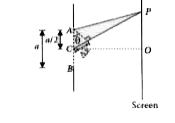At the first minimum adjacent to the central maximum of a single-slit diffraction pattern the phase difference between the Huygens wavelet from the edge of the slit and the wavelet from the mid-point of the slit is
π radian
π8 radian
π4 radian
π2 radian
The correct Answer is:A
The situation is shown in the figure.

In figure A and B represent the edges of the slit AB of width a and C represents the midpoint of the slit. For the first minimum at P,
asinθ=λ ...(i)
where λ is the wavelength of light.
The path difference between the wavelets from A to C is
Δx=a2sinθ=12(asinθ)=λ2 (using (i))
The corresponding phase difference Δϕ is
Δϕ=2πλΔx=2πλ×λ2=π
Topper's Solved these Questions
Similar Questions
A 0.20 mm wide slit is illuminated by light of wave- length 420 nm. Consider a point P on a viewing screen on which the diffraction pattern of the slit is viewed, the point is at 30∘ from the central axis of the slit. What is thc phase difference between the Huygens wavelets arriving at point P from the top and midpoint of the slit?
View SolutionIn single slit diffraction pattern :
View Solution
Knowledge Check
- Question 1 - Select One
At the first minimum adjacent to the central maximum of a single slit diffraction pattern, the phase difference between the Huygen's theh wavelet from the edge of the slit and the wavelet from the edge of the slit and the wavelet from the edge of the slit and the wavelet from the midpoint of the slit is
Aπ4 radianBπ2 radianCπ radianDπ8 radian - Question 2 - Select One
In a single slit diffraction pattern
ACentral fringe has negligible width than othersBall fringes are of same widthCCentral fringe do not existDcentral fringe is twice as wide as other maxima - Question 3 - Select One
In single slit diffraction pattern :
Acentral fringe has negligible width than othersBall fringes are of some widthCcentral fringe does not existDnone of the above
Angular width of central maxima of a single slit diffraction pattern is independent of
View SolutionNo fringes are seen in a single-slit diffraction pattern if
View SolutionThe angular size of the central maxima due to a single slit diffraction is (a → slit width)
View SolutionIn a single slit diffraction pattern intensity and width of fringes are
View SolutionCentral fringe obtained in diffraction pattern due to a single slit-
View Solution

